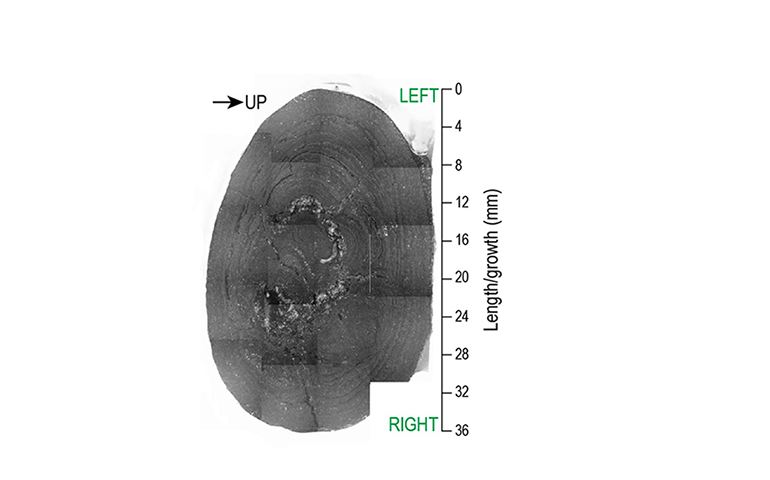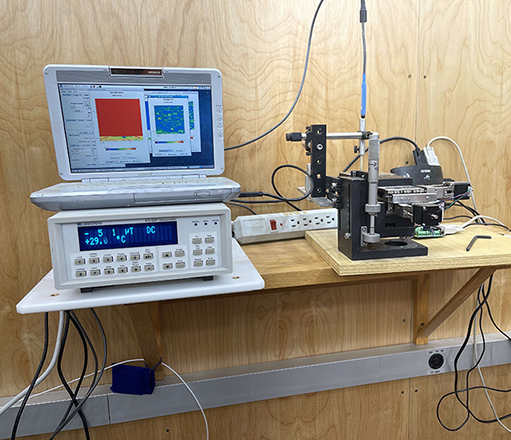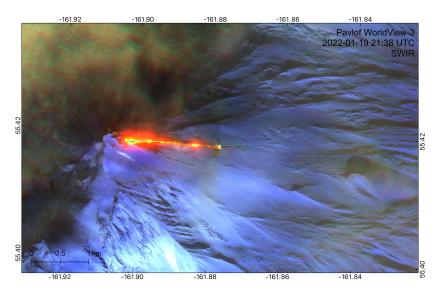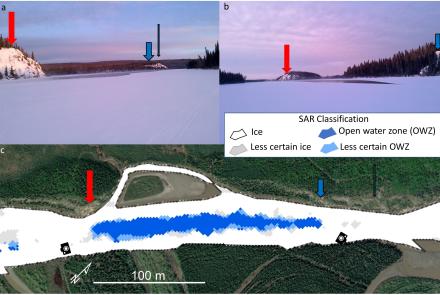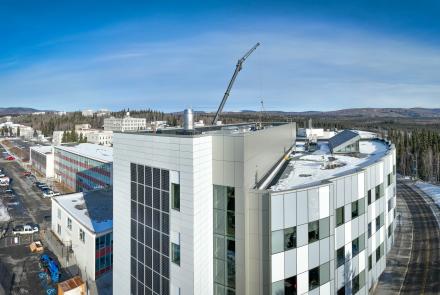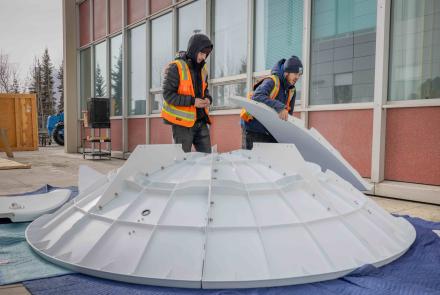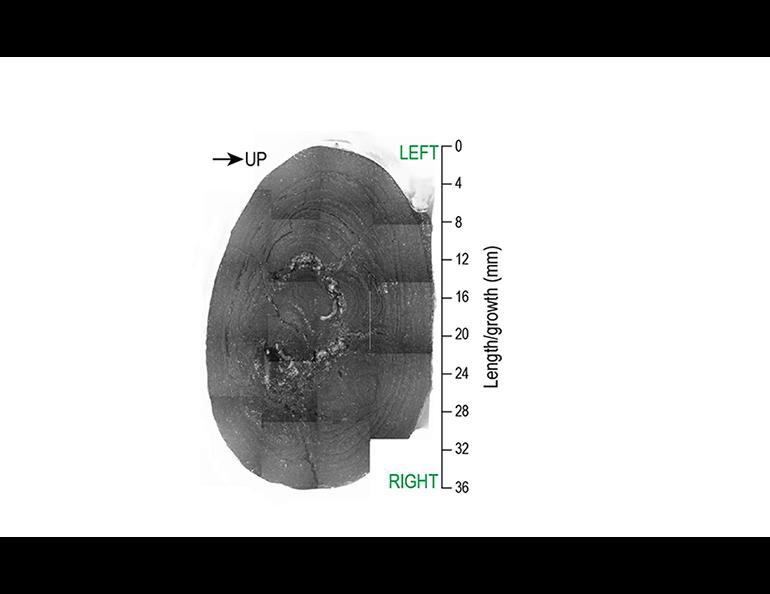
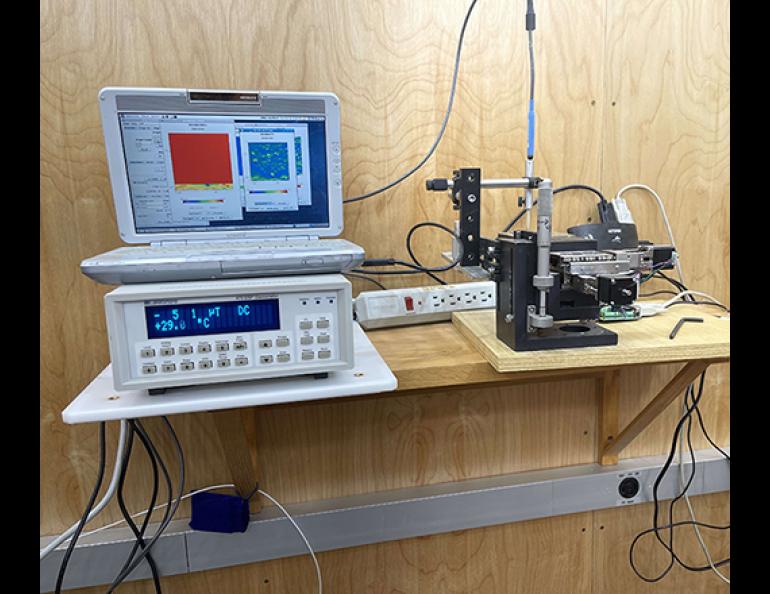
Paleomagnetism aids research on the Northern Hemisphere Glaciation
A small piece of Pacific Ocean floor, brought up 10 years ago by a Chinese research vessel from a depth of 16,500 feet and 2,700 miles from the San Francisco coast, has a large story to tell.
Researchers say a one-fifth-inch slice of that marine ferromanganese nodule, which measured 1 by 1.4 inches before it was sliced open for analysis, contains information about the behavior of the Northern Hemisphere Glaciation. That event began approximately 2.7 million years ago.
The research was published Feb. 24 in the journal Science Advances. Associate research professor Gunther Kletetschka at the University of Alaska Fairbanks Geophysical Institute is among the 11 contributors. The research was led by Liang Yi of Tongji University, Shanghai, China.
None of the information gleaned from the nodule could be properly placed on Earth’s geologic timeline, however, without knowing the nodule’s precise age.
And that’s where paleomagnetism expert Kletetschka comes in. Paleomagnetism is the study of magnetism imprinted on rocks by Earth’s magnetic field at the time of the rocks’ formation.
Kletetschka used a high-resolution magnetic scanner in the UAF Reichardt Building to analyze the nodule slice.
“Through magnetic scanning, we found that the age of this nodule is about 4.7 million years,” he said.
To get that precision, Kletetschka used a method he and others developed and reported in 2020. The process involves magnetic and chemical scanning and analysis of beryllium isotopes and cobalt atom concentration.
The research also revealed the age of the individual layers in the sample’s interior. The dating was possible because the magnetic scanning revealed the changes in Earth’s polarity imprinted on the nodule over millions of years.
“With the outside of the nodule we see that the magnetic field is in the direction of today's magnetic field,” Kletetschka said. “But when we went about half a centimeter into the nodule, we saw that the polarity had reversed.”
A series of rings within the sample disclosed a history of polarity change. Scientists then matched that against the known history of Earth’s polarity changes. The planet’s polarity has been reversing every 200,000 to 300,000 years for about the last 20 million years, though it has been more than twice that since the most recent change.
The sample nodule likely grew from a single grain of sand. Kletetschka explained that the ocean bottom contains a lot of iron and manganese. The depths also contain higher levels of free dissolved oxygen, which leads to oxidation of the iron and manganese.
“This allows some atoms of the iron and manganese to precipitate onto a tiny grain of sand,” he said. “And it continues over the ages, making a nodule that gets bigger and bigger.”
For the researchers, marine ferromanganese nodules and other crustal formations of metal oxides become recorders of bottom-water oxygen levels.
Knowing the oxygen level reveals the strength and weakness of what is known as ocean ventilation. The deep Antarctic water, known as Antarctic bottom water, is a key factor in global ocean ventilation.
Ventilation occurs through thermohaline circulation, also known as the global conveyor belt. On that conveyor, surface water that has moved into the Arctic and the North Atlantic Ocean sinks as it loses heat to the cold atmosphere and becomes saltier with the formation of sea ice.
As it sinks, it forces the existing Atlantic deep water south toward Antarctica. It carries with it salinity and dissolved gases such as oxygen absorbed at the surface.
It eventually reaches the planet’s coldest and densest water — Antarctic bottom water, which is fed also by sinking Antarctic surface water that has become dense due to increased salinity as some seawater turns to ice. That surface water is also rich in oxygen, because seawater can attract more of it as the temperature drops.
The ocean conveyor carries the oxygen-rich Antarctic bottom water, or AABW, into the Pacific and Indian oceans, where it restores depleted oxygen levels and eventually rises as it meets warmer water. Currents take it back to the Atlantic Ocean, completing a circuit of 1,000 years.
The free oxygen carried into the Pacific interacts with iron and manganese, creating nodules like the one pulled from the deep Pacific in 2013.
The paper’s authors say the nodule formed in conditions similar to those of the deep Southern Ocean and that it can therefore serve as a research proxy.
With a precise date derived from Kletetschka’s work, researchers were able to place on Earth’s geologic timeline the oxygen-level indicators revealed by chemical scanning of the nodule’s rings. They found a correlation with behavior of the Northern Hemisphere Glaciation.
The result is a record of deep-sea ventilation going back 4.7 million years, the age of the nodule.
The researchers say the data provides “compelling evidence” of a link between episodes of low bottom-water oxygen, Antarctic ice sheet dynamics and evolution of the Northern Hemisphere Glaciation.
All of that from analysis of a slice of a ferromanganese nodule in Fairbanks.
Gunther Kletetschka, University of Alaska Fairbanks Geophysical Institute, 907-474-7090, gkletetschka@alaska.edu
Rod Boyce, University of Alaska Fairbanks Geophysical Institute, 907-474-7185, rcboyce@alaska.edu

